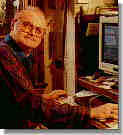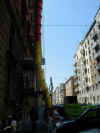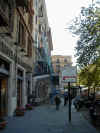
When You Go By The Via Flaminia
Friday, April 26, 2002
Sections
Alt.Mail
Special Reports
When you go by the Via Flaminia, by the legions'
road to Gaul,
Remember the luck of the soldier, who rose to be master of all.
He carried the sword and the buckler, he mounted his turn on The Wall,
And the Legions elected him Caesar, and he rose to be master of all!
It's twenty-six marches to Narbo, and thirty-one more up the Rhone,
and maybe it's death in the heather, or life on the Emperor's throne...
Kipling's poem depicts an old marching song of the Legions. It's probably not genuine, but it could have been, and it runs through your head when you come to the Via Flaminia.
As you can see, I brought Chaos Manor to our Roman apartment. The table is a bit littered... I set about about 2 PM. Our apartment is in the Vatican district -- well not entirely. The Vatican district is called Borgo, and ours is a more modern middle class district called Prati, but we're on the same side of the river, the right bank if you face downstream. I blush to say I don't remember if you face upstream or down when you decide which is left and which is the right bank. In any event, if I go out of our apartment onto Via Duilio and turn right, it shortly turns into Via Atillo Regno, then becomes Virgilio street -- not far is Ovid, there is a Cicerone, and if you ignore the way street names change from block to block our apartment is at the corner of Virgil and Julius Caesar, with Pompey the Great the next street over. Eventually I come to a big shopping street. Following that to the Margherita Bridge takes me to the Piazza del Popolo, Square of the People, which is where the old north city gate was.
On the way I spotted this construction gimmick. Colorful and useful, and I don't know why I thought it worth including. But I did.
There's also a colorful church in the square near our apartment. Rome is full of sights like this. I suppose most cities are but you don't notice them in your own city. The church is San Gioacchino in Prati, and inside it is very ornate, with chapels labeled Hibernia, Poland, Canada, Bavaria, Belgium, and Lusitania. I blush to say I don't remember where Lusitania is, or when this church was built, although I'd guess later than 1870. On through the square to Via Cola de Rienza, the main shopping street of the Prati district.
This picture isn't important, but I thought it amusing. The workman up above is shouting to get the attention of the chap seated below. Everyone in the square has heard him. Everyone except his partner who is apparently lost in thought. I have no idea how that story comes out.
The Rienza leads across the Ponte Margherita where it turns into the Via F. di Savoia. I don't know what the F. means. Parallel to this is the Via L. di Savoia, and I don't know what the L. stands for either. The Italian kings from 1870 until the plebiscite abolishing the monarchy after World War II were of the House of Savoy. I find later that F. is Ferdinando and L. is Lodovico. I don't think either of them were ever kings. Moving along V. F. di Savoia
a busload of Roman schoolchildren, and then
The first sight of the Square of the People lets you know this is going to be a Big Deal.
And indeed it is a Big Deal. This is looking north to the gate. Beyond that gate is the Via Flaminia, which leads north to the Milvian Bridge, where Constantine the Great saw a fiery sign in the sky the night before his decisive battle. In Hoc Signo Vinces, in this sign, conquer; and he did. Constantine ended persecutions on his conversion in 313 A.D. In A.D. 380 Theodosius made Christianity the official state religion. The Empire became Christian rather than pagan, and the Popes slowly began taking over the rule of the city, rather completely after the seat of Empire moved to Ravenna and Constantinople. It was of course the Popes who rebuilt this Piazza del Popolo, as you can tell by the twin churches as you look back from the square toward the city to the south.
Looking across the square you see trees: that's the Pincio Gardens and beyond them the Villa Borghese up there. The church beyond the obelisk is built on the site where the Emperor Nero's ashes were buried. He is said to have haunted the area until a chapel was built over the site in 1092. The obelisk is the one Augustus brought over after the conquest of Egypt from Cleopatra and Marc Antony, and formerly dominated the Circus Maximus. Long after the Circus was in ruins Pope Sixtus V had the obelisk brought here to the Piazzo del Popolo.
A closer look at the Rostra below the Pincio Gardens. This is of course Papal neo-classical, but it was probably designed to look a bit like the old Rostra in the Forum in Republican-Imperial times.
Back in the square on the church steps,
The last time the Goths came to Rome it was a much bigger deal, and things got a lot worse. These Goths are merely local color...
And above three pictures: one looking through the gate north up the Via Flaminia toward the Milvian Bridge, and two from outside on the Via Flaminia looking in and down toward the city of Rome. The old Roman Wall is pretty well gone, and what you see now is Renaissance Papal, but surely it was impressive enough in its day. The picture on the right shows the twin churches that dominate the road into the city. They look identical, but they were built on different sized and shaped lots, and getting them to look alike was an architectural challenge.
We now move down the Via Flaminia toward Rome. The street is called Via del Corso now and it's a major shopping street. One of my maps shows that it was called Via Lata in ancient times, Via Flaminia beginning at the gate (where it begins now). Roman streets change names a lot, and I suppose that's an ancient practice. This is an old street, and has been a major shopping street at least since the time of the Popes, and possibly before that.
Of course there have been a few changes since Papal times. Actually, most of the shops are fairly small, even those with recognizable brand names; and many have names recognized by worldly wise shoppers but which no one in the US will know except from experience or possibly guide books. Many are closed from 1:00 to 3:00 P.M. There's not a lot of variety, either. When I was last in Rome every Italian businessman carried a shoulder bag taller than it was wide, and I bought a good one, but it's not large enough for cell phone, PDA, camera, notebook, and all the other stuff I have learned to carry since those times. Terry Pratchett has a nice leather bag he got in Rome a few years ago, just the right size for all the new stuff. I have not seen one single one like it. Now everyone carries fairly normal brief cases, too large for what I want: if I want one in that shape, ballistic nylon is lighter and comes with padding for small computers. And there aren't any shoulder bags in what I suppose I could call "portrait" as opposed to "landscape" configuration. Oh. Well. Onward.
We come to the Piazza Colonna, square of the column dedicated to Marcus Aurelius, and a sight you can see from that square. Aurelius was the last "good" emperor. He was followed by his rotten son, who was followed by a Senatorial martinet, who was assassinated by the Praetorians who then literally sold the Empire to the highest bidder. They held an auction. The emperor they chose didn't last because at this point Septimius Severus marched in, disbanded the Praetorians, and ruled in his own way. He had discovered the dread secret: Emperors could be made in places other than Rome.
Severus put a tax on public urinals, and when his sons complained that this was undignified told them "Money doesn't stink." Later on his death bed he told his sons "Stay together, pay the soldiers, and take no heed of the people." They didn't stay together, and the soldiers overthrew the winner of that particular fight. And the Legions elected their Caesars from then on...
I saw a sign indicating that the Pantheon was off to the right, and took that alleyway.
This led to a clothing store. We saw a similar one in the Borgo near the Vatican. This one is in the Campus Martius district. If you want to dress up as a bishop or cardinal, they don't ask for credentials, but the prices aren't cheap. On to
Santa Maria sopra Minerva, a Gothic church built over an old Temple to Minerva, and the burial place of St Catherine of Sienna (d. 1380). The right hand picture shows the high water mark of Tiber floods over several centuries. If you look carefully on the picture at the left you'll see those marks on the right side of the church. The lowest was at about my eye level. The elephant is by Bernini. The obelisk was found in the gardens here. Bernini intended the space under the elephant to be open, but a monk insisted that it would be unstable, so the enormous saddle cloth was added to the design. Then
the first sight of the Pantheon from Piazza della Minerva. Moving on,
there have been some changes in the views around the Pantheon since pagan times. Of course the Popes made a church of it at one time, but that didn't last. (Actually, it did last: it's still a parish Church, and Mass is said there; but it is also open to the secular public.) It's a very popular place not only for tourists but for Romans to meet. Raphael is buried here. So are some of the kings of modern Italy.
Further along into the Campus Martius they found some ancient temples but no one is quite sure what they were for.
The current inhabitants are quite sure they know what the place is for. They're quite tame, and I suppose they live by begging. Moving on to the River now:
The main Jewish Temple in Rome. It may not be obvious that the Carabiner is wearing body armor and carrying a machine gun. His comrades down the street are as you usually see the National Police, pistols only and no body armor. There is a fair amount of police presence in Rome, but I saw few of them in body armor and this has been the only machine gun I have seen. There are a number of varieties of police, but the Carabinieri are an elite national paramilitary unit. It was a Colonel of Carabinieri who informed Mussolini that the King had dismissed him as Il Duce.
The last time I was in Rome, which was some years ago, you saw a lot of signs proclaiming public works, either done by or at least begun by, Umberto, Rex, Benito Mussolini, Duce. I have seen few of those this trip, which may be a function of where I have gone, but I think it more likely they have been cleaning up -- and doing new projects. There was a lot of effort put into making things spiffy for the Jubilee Year and the New Millenium. Some remain, like at the opera house, but most of the credits to Mussolini seem to have vanished.
Which ends Part One; we'll go back by home by the Via Flaminia, but first a detour along the Tiber in search of the Knights of Malta.
I append some remarks by a reader:
Those temples in the Campus Martius, are, if I'm not mistaken, a group of small early republican temples dedicated by triumphators. They lie at the end of Pompey's Portico and are are: Juturna, Fortuna, Feronia, and Lares Permarini. The area is also called the Largo Argentina.
the temple behind the cat in this picture:
http://www.jerrypournelle.com/images/photos2002/ROME/p4260085.jpg
is Juturna's
Almost everything you read on those big multilingual signs is suspect by the way. Richardson's "A New Topographical Dictionary of Ancient Rome" is both affordable and reliable.
































